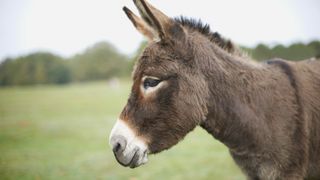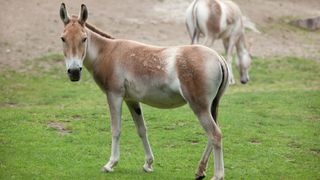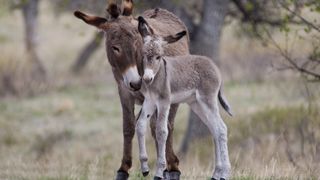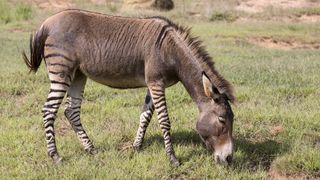Facts about donkeys
Donkeys, also called burros and asses, are found throughout the world.

Donkeys, also called burros and asses, are found throughout the world. They are members of the Equidae family, which also includes horses and zebras. They look a lot like their equine cousins, but have long, floppy ears and tend to be stockier than horses or zebras.
How big are donkeys?
There are three main types of donkeys: wild, feral and domesticated. Wild donkeys typically grow to around 49 inches (125 centimeters) from hoof to shoulder and weigh around 551 pounds. (250 kilograms).
Domesticated donkeys vary in size, depending on how they are bred. There are eight different breeds of domesticated donkeys, according to the Oklahoma State University. (Breeds are lineages in which certain traits are preserved or eliminated through artificial selection.) On average, domesticated donkeys are slightly smaller than their wild cousins, typically weighing from 400 to 500 pounds (180 to 225 kg) and measuring 36 to 48 inches (92 to 123 cm) from hoof to shoulder.
The smallest donkey breed is the miniature donkey, according to the University of Michigan's Animal Diversity Web. They grow to only around 36 inches (92 cm) from hoof to shoulder and weigh less than 400 pounds. (180 kg). Mammoth stock, which is the largest donkey breed, grows to be 56 inches (143 cm) from hoof to shoulder and weighs about 950 pounds. (430 kg).

Where do donkeys live?
Wild donkeys are found in deserts and savannas in northern Africa from Morocco to Somalia, in the Arabian Peninsula and in the Middle East. One species, the kiang or Tibetan wild ass, is found in China, northern parts of Pakistan, India, Nepal and Bhutan, and in northern parts of Pakistan.
Domesticated donkeys, on the other hand, are found all over the world, but they prefer dry, warm areas. The Abyssinian donkey, for example, is bred in Ethiopia, according to Oklahoma State University, while the Anatolia donkey is bred in Turkey.
What are donkeys' habits?
Male donkeys are called jacks and females are called jennets or jennies. Donkeys are very social and usually live in a group called a herd. A wild herd is usually led by one jack and includes several jennies. Some larger wild herds have been found that include several males. As long as the additional males are submissive to the dominant male, everything goes smoothly. Donkeys don't seem to form strong social bonds, however. Wild herds often break up and reform with new members on a regular basis.
Donkeys rest during the hottest part of the day. They are more active during the early mornings and evenings, when they travel and graze with their herd.
Domestic donkeys are typically used as pack animals or for milk, according to the Global Invasive Species Database. Sometimes donkeys are trained to protect other livestock from predators, as they typically attack when threatened and will guard other animals if they are bonded to them, according to the Donkey Sanctuary of Canada.
What do donkeys eat?
Donkeys are grazers that typically like to eat grass, though they also eat shrubs and desert plants. Instead of tearing at grass with their teeth, donkeys grab the plant with their lips, pull it into their mouth, then rip it with their flat teeth and grind it down for swallowing.
Donkeys are voracious eaters. A donkey can consume as much as 6,000 pounds (2,722 kg) of food per year, according to the Global Invasive Species Database. This massive amount is concerning when it comes to feral donkeys, which can move into habitats and take food from the local animals.
How do donkeys reproduce?
Just as donkeys don't seem to care who's in their herd, they also don't seem to be picky about who they breed with. In addition to other donkeys, they will breed with horses and zebras, producing hybrid offspring. A jack that mates with a female horse will produce an animal called a mule, while a jenny and a male horse produce a hinny, according to the University of Miami. When a zebra and a donkey mate, the result is called a zebroid, zonkey or zeedonk. Hybrids are almost always sterile and cannot produce offspring of their own.
Female donkeys have a gestation period of around 12 months, and baby donkeys are called foals. Foals weigh between 19 and 30 pounds (8.6 to 13.6 kg) at birth and can stand and nurse just 30 minutes after birth. At 5 months, foals are weaned and at 2 years they are old enough to mate. Females typically give birth to a new foal each year.

Donkey taxonomy and classification
Kingdom: Animalia Subkingdom: Bilateria Infrakingdom: Deuterostomia Phylum: Chordata Subphylum: Vertebrata Infraphylum: Gnathostomata Superclass: Tetrapoda Class: Mammalia Subclass: Theria Infraclass: Eutheria Order: Perissodactyla Family: Equidae Genus: Equus
Species:
Equus asinus — burro, donkey, ass
Equus hemippus — Syrian wild ass, achdari
Equus khur — Indian wild ass, khur
Equus africanus — African wild ass
Subspecies:
Equus africanus africanus — Nubian wild ass
Equus africanus somaliensis — Somali wild ass
Equus hemionus — Asiatic wild ass, onager, kulan
Equus hemionus hemionus — Mongolian wild ass
Equus hemionus kulan — kulan, Turkmenistani onager
Equus hemionus onager — Iranian onager
Equus kiang — Tibetan wild ass, kiang
Equus kiang holdereri — Eastern kiang
Equus kiang kiang — Western kiang
Equus kiang polyodon — Southern kiang
Source: Integrated Taxonomic Information System (ITIS)
Are donkeys endangered?
While domestic donkeys are in no threat of extinction, the same cannot be said for wild asses. According to the International Union for Conservation of Nature (IUCN), the African wild ass is critically endangered, with only 23 to 200 adults left. Asiatic wild asses are classified as near threatened, with a population of around 28,000.

Additional resources
There are millions of feral donkeys living across Australia, you can find out more about their environmental impact by downloading a fact sheet from the Australian Department of Sustainability, Environment, Water, Population and Communities. Learn about the origins of donkey breeds from the Donkey Sanctuary in the U.K., and meet the smallest of these breeds — miniature donkeys — at the website of Oklahoma State University's Division of Agriculture.
This article was updated on Feb. 4, 2022 by Live Science senior writer Mindy Weisberger.
Bibliography
"Breeds of Livestock, Department of Animal Science." Listing of Donkey Breeds - Breeds of Livestock, Department of Animal Science, Oklahoma State University, http://afs.okstate.edu/breeds/other/donkey/.
Huggins, Britton. "Equus Asinus (ASS)." Animal Diversity Web, University of Michigan Museum of Zoology, http://animaldiversity.org/accounts/Equus_asinus/#physical_description.
GISD, Invasive Species Specialist Group, http://www.issg.org/database/species/ecology.asp?si=639.
"Donkey Myths." Donkey Myths, The Donkey Sanctuary of Canada, https://www.thedonkeysanctuary.ca/information/donkey-myths.
Equus Hybrids, University of Miami College of Arts and Sciences: Biology, http://www.bio.miami.edu/dana/dox/equus.html.
"Integrated Taxonomic Information System - Report." ITIS, http://www.itis.gov/servlet/SingleRpt/SingleRpt?search_topic=TSN&search_value=180690.
Moehlman (Columbia University EcoHealth Alliance), Patricia, et al. "The IUCN Red List of Threatened Species." IUCN Red List of Threatened Species, 8 Sept. 2014, https://www.iucnredlist.org/species/7949/45170994.
"About Donkeys." The Donkey Sanctuary, https://www.thedonkeysanctuary.org.uk/what-we-do/knowledge-and-advice/about-donkeys.
Sign up for the Live Science daily newsletter now
Get the world’s most fascinating discoveries delivered straight to your inbox.
